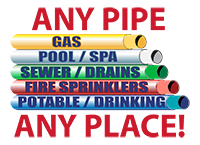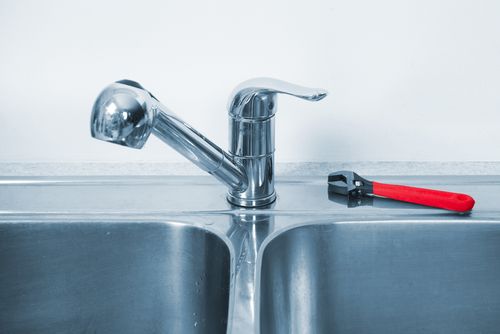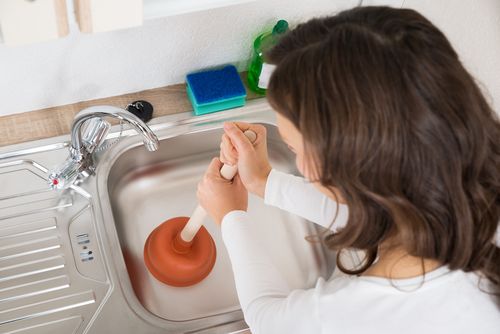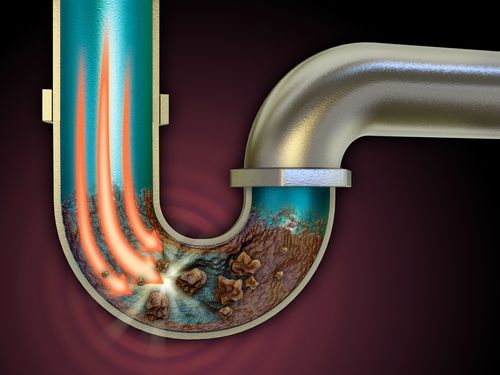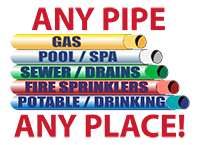If you don’t already know how to unclog a sink, this is a skill that you absolutely need to learn. Kitchen sinks can get clogged when you dump cooking oil and bits of leftover food down the drain, and bathroom sinks can get blocked up with hair and toothpaste residue over time. Because clogged sinks are so common, it comes in handy to know how to unclog a sink yourself, rather than having to call in a plumber every time. Here’s how to do it right.
Start with a Plunger
In many cases, a blockage in your sink can be cleared using a plunger. This is an item that you most likely already have in your house, so you won’t even have to spend any money to utilize this method.
You’ll use the plunger in much the same way as you would to clear a blocked toilet. Place the mouth of the plunger over the drain in question, making sure to create a tight seal all the way around. Next, pump the plunger up and down, maintaining the seal as you do. This forces air and water back and forth through the pipes and is often enough to loosen up the blockage.
For a single sink, this is all you need to do. If you have a double sink, though, you’ll need to use the plunger on both sinks, not just the one that won’t drain, to ensure that you have removed all of the blockage. If you have plunged until your arms are sore and the clog still won’t budge, move on to the next step.
Clear the Trap
If the plunger doesn’t work, your next course of action is to clear the trap. This is the U-shaped section of the pipe. You can find it easily in the cabinet underneath the sink.
The trap serves an important purpose for your sink. After the water has all flowed down the drain, a small amount of it stays in the bottom of the curve in the trap. This creates a seal that prevents sewage from coming back up through your pipes and into your sink. Although the trap does have an important purpose, it is also a common collecting point for debris, so it can become clogged fairly easily.
Before you remove the trap, have a bucket or cup ready to dump the retained water into so that you don’t make too much of a mess. Unscrew the brackets on either end of the trap, and it will come out easily. Once you remove the trap, you’ll be able to easily see any blockage inside it. Push the blockage out with your finger, a pen, screwdriver or other item, taking care not to damage the part in the process.
If the blockage is not in the trap itself, check the piping on either side of the gap where the trap once was. If you can see a blockage, you should be able to remove it quite easily. If you are unable to see anything, the blockage is likely farther along the pipes, and you’ll need to take more drastic measures to fix the clog.
Use a Drain Snake
If the two previous methods have not worked, your next course of action is to use a drain snake. You can purchase a drain snake at most hardware or home improvement stores. However, drain snakes are not cheap, and it is unlikely that you will need to use one very often, so you are probably better off just renting one for the day. Many home improvement or hardware stores offer this service as well.
A drain snake works by rotating a coil within your pipes. The rotating motion dislodges any debris that has accumulated along the sides of the pipes so that they can flow smoothly once again. It is important to note, though, that snakes can be fairly hard on your pipes, so you should avoid this method if your pipes are made from PVC, plastic or similar materials.
A key drawback to using drain snakes is that they have a limit to how far into your pipes they can reach. The snake can only reach as far as its coil is long, so if the snake can’t get rid of the clog, it means that the blockage is too far into your piping. In this case, you’ll need to call in a professional to locate and eliminate the blockage.
Call a Plumber
If you have already tried all of the steps outlined here and are still having no luck with getting rid of the clog, it’s time to call in the services of an experienced plumber. A plumber will have the skills, experience and equipment needed to get rid of even the trickiest clogs.
In many cases, it is not actually a clog at all, but rather a tree root that has grown through your pipes. This can be an incredibly difficult blockage to remove, so it is always best to leave this task to the experts.
Your plumber can advise you on any steps you need to take to fix the problem and should always provide you with a detailed cost estimate before beginning any work. Any plumber who refuses to provide a price quote in advance is likely disreputable, and you should find a different plumber.
If possible, you should always take a look at the plumber’s credentials and experience, and check out some online reviews to find out what people are saying about their work.
Prevent Future Clogs
Once the clog is gone, you’ll want to prevent blockages from happening again in the future. Follow these simple tips to stop clogs before they start:
- Don’t dump used cooking oil and grease down the kitchen sink. Over time, the residue can build up, creating a clog. Instead, wait for it to cool, then pour it into the trash. There are also some facilities that utilize used cooking oil and can dispose of it in a way that is safe for the environment, so check to see if there are any in your area.
- Install drain catchers in all of your drains. These handy devices catch any debris in the water so that it doesn’t flow down the drain and into your pipes. You can find them at many home goods stores and online, and you’ll typically only pay about $10. When a catcher gets full, simply remove it, and dump the contents into the trash. Give it a quick wash, put it back in the drain, and you’re good to go.
- If you shave over the bathroom sink in the morning, don’t wash all of the trimmed hair down the drain. Wipe it away with a towel, or suck it up with a vacuum instead. It may only seem a small step, but this can save you a great amount of trouble over time.
- Have a supply of drain cleaner handy. If clogged sinks are a common occurrence in your household, it is a good idea to always have a bottle of drain cleaner at the ready. You can buy drain cleaner at a wide range of stores, including home improvement, hardware, grocery and convenience stores, to name a few. You can also make a DIY version if you prefer to avoid harsh chemicals. Use the drain cleaner whenever you notice that the flow through your drain is starting to slow. Oftentimes, this is enough to get rid of any residue before it fully clogs.
- When planting trees around your home, keep in mind that the root structure will extend as far out from the trunk of the tree as the branches do. Be sure that you plant trees a safe distance away from your plumbing so that the roots don’t grow through the pipes. Don’t forget to think about how much the tree will grow in the future as well.
Expert Pipe Services in San Diego
Here at San Diego Plumbing and Pipelining, we offer a variety of pipe repair, replacement and installation services, including clearing clogs. We’ll come out to your San Diego home or business to inspect the problem, locate the clog and remove it safely and effectively. We will always provide you with a detailed cost estimate before we begin any work so that you know exactly what to expect when the bill arrives.
We take great care in our work not to damage your pipes or property. Our technicians are experts at what they do and can get the job done right the first time. After we are finished, we’ll always clean up after ourselves, leaving your home or office cleaner than we found it.
For all your piping needs in San Diego, we should be your first and only call. Our friendly team are always happy to discuss your needs with you and send out an expert plumber to help you with any clogged drain problems, large or small. Get in touch with us today to learn more about our services and how we can help you keep your pipes clog-free.
